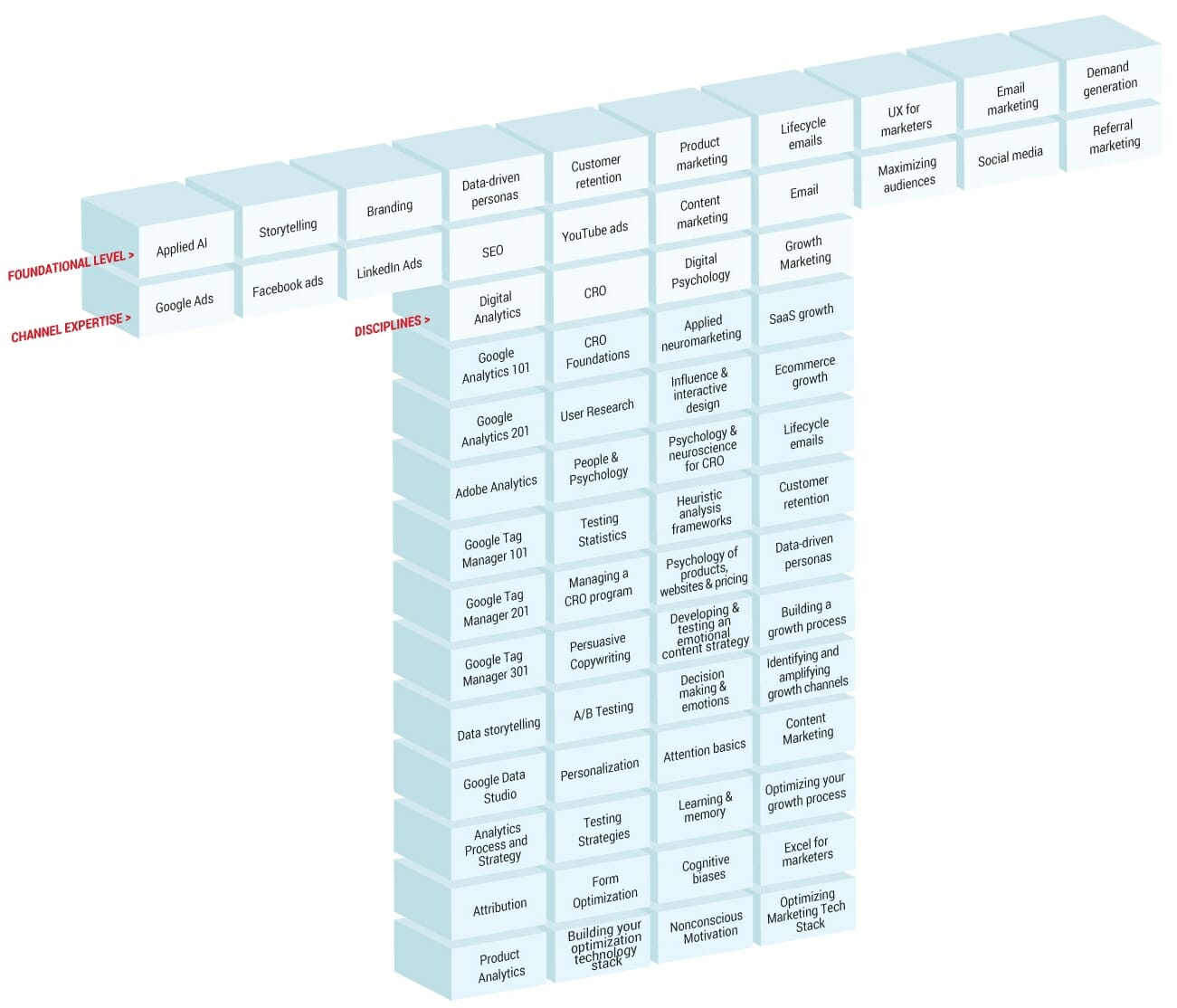Expecting a laundry list of skills or tactics? Don’t.
“Tactics are a dime a dozen,” says GrowthTribe’s David Arnoux, “and what works for me won’t work for you. In the end, it’s all about having a growth engine and running as many (quality) experiments as possible.”
We asked Arnoux and other growth experts what actually works, what matters most, and why so many fall short.
Four things came up over and over again.
Table of contents
1. Results, expected and exponential
This could be the whole post:

If your growth program—no matter how well staffed, no matter the velocity of experimentation, no matter the quality of ideas—isn’t making money, it’s failing.

Not all results are the same, either. “A ‘good’ growth team improves funnels for one-time bumps,” argues Lars Lofgren, CEO of QuickSprout. “A ‘great’ growth team focuses on levers for exponential growth.”
No one cares about a team or individuals’ “experience” with platforms or channels. The only thing that matters is translating that knowledge into more money. Anything else isn’t mastery—it’s academic.
The wins that go beyond one-time bumps require exceptional knowledge—but only as a starting point.
Executing on core tasks is table stakes for the company-changing work, as Laura Borghesi, Senior Director of Growth Marketing at MongoDB, details:
If every team member has strong business acumen, is a self-starter who acts like the “business owner” of their area, has top-notch execution skills, and helps others execute on their projects, too, I know that the planned things will get done.
Then, we can spend time pushing our thinking toward bold new ideas. That’s the biggest difference between teams that are “okay” versus teams that become the first movers.
Mailchimp’s Willie Tran agrees. Hockey-stick growth requires being ahead of, not in line with, conventional wisdom:
The most impactful ideas won’t be found in “best practices.” Instead, ideas should be rooted from first-principles thinking.
You should be asking yourself, “Why would this work?” but answer the question in non-technical terms or with a real-life parallel.

Getting great—not just good—results already assumes that your team is executing on the most important tasks at high speeds. That’s not easy.
“The hardest thing about running a growth team,” confirms Dan Layfield of Codecademy, “is picking exactly what to work on.”
2. Executing on the right tasks—fast

“The more you experiment, the more you can learn,” says Tran.
“Seventy percent of your experiments will be losses. This number is less daunting when you have a high experimentation output.”
Few are hitting that goal, according to Arnoux:
A team that doesn’t have the right capabilities will need to outsource those capabilities, which means handovers, which hinders the time it takes to run an experiment.
Can a team build their own assets? Manage their own copywriting? Crunch their own data? Run their own campaigns? Build their own feature list? Design their own onboarding flow? Create their own financial models—or even manage their stakeholders?
Assuming you are moving fast, it’s easy to get tempted by quick but short-lived wins.
“Great growth teams spend all their time on user-driven growth—invite flows, sharing, etc.,” explains Lofgren. “Good growth teams spend a lot of time optimizing a standard sign-up funnel. But picking the business model and building a product for user-driven growth is very difficult to do intentionally.”

That uncertainty doesn’t justify randomness, as Privy’s Dave Gerhardt cautions.
Merely “good” teams “do crazy experiments just because ‘that’s what growth teams do’ versus focusing on delivering real, clear business results.”
The ability to pick the right experiments, of course, depends on the range of options your team’s skills and experience can support.
3. Breadth of knowledge, depth of experience

“Potential hires don’t have a 10-year experience that confirms they’ll be great,” concedes Borghesi.
“So, the hardest part is to spot the potential and place a bet. Is the potential hire showing the grit, the flexibility, and resilience that tells you they’ll be able to figure it out along the way?”
At a hard-skill level, it requires T-shaped people. “T-shaped teams,” explains Arnoux, “possess a broad range of skills and knowledge while also being experts in a few specialized fields. T-shaped teams just move faster and smarter.”

T-shaped, at its core, is a commitment to ongoing growth. The T is to show you what to do next, not to congratulate you on what you’ve done.

Great growth people, affirms Gerhardt, have a curiosity that leads them to ask “who else has done this, who are role models, which patterns can we copy, etc.”
“The best marketing teams in the world today,” Joanna Lord told the audience at The Inbounder, “have T-shaped, domain-agnostic talent.”
“This is raising the bar,” Lord continued:
You’re asking every marketer on your team to have deep knowledge across the full funnel—deeply versed in analytics, well-versed in content, well-versed in landing page design, all of it.
The solution isn’t just to learn a platform or channel. It’s a willingness to ask hard questions about how you and your data fit into the rest of the organization. Answering those questions requires you to learn new skills—indefinitely.

“You can become the best web analyst,” explained Simo Ahava, “but that’s really insignificant when you consider that analytics today is cross-disciplinary. You have financial analytics, you have business analytics, you have behavioral analytics, offline analytics.”
“I can put most of my marketers, any of them, interchangeably into any room,” Lord said, “and they can represent the entire team.” What’s the value of that? “Redundancy,” Lord explained, “helps you run faster than your competitors.”
Which new skills should you prioritize? It varies by company, says Arnoux:
It depends on the industry, the maturity of the product, the regulatory framework, the culture of the organization (including branding, compliance, legal), the business model, the metric they’re focusing on, the length of the sales cycles, and the resources available.
In other words, growth marketing tactics constitute only a fraction of the requisite knowledge.
4. A vision for the big picture
“The company context and the external context (the world) are shifting at a rapid pace,” says Arnoux. That reality is currently in sharp focus. “What the team learned or implemented three months ago,” Arnoux continues, “might not be relevant today. It’s exciting and terrifying at the same time.”

Paddle’s Ed Fry has a ready example. He touts “fully integrated event-based, intent-driven, account-based marketing” as his company’s most successful strategy in 2019.
“Any time one of our target accounts shows a buying signal,” he explains, “we’re able to react and engage them.”
And yet, change comes rapidly. “With the coronavirus outbreak,” says Fry, “the match rates for reverse IP lookup are declining. This makes it harder to engage target accounts digitally.”
The solution? They’re “doubling down on brand and content.” That shift would be impossible without speed, flexibility, and deep knowledge and experience across growth channels. It would also be impossible without organizational buy-in.
One of the hardest parts of growth, Layfield acknowledges, is “getting the organizational alignment for resources and a clear roadmap.”
Gerhardt agrees that a primary challenge is “finding out where growth fits inside of the company (product, marketing, engineering) and getting executive buy-in.”
That’s if it’s a fit at all, according to Lofgen: “The best thing a good growth team can do is move to a business or product that has the right conditions for exponential growth through optimization.”
He recalls an epic battle over a homepage redesign that, while crushing key metrics, struggled to gain support:
Multiple executives hated this page. I had to defend it regularly to keep it live. After I left, the homepage immediately changed to something more generic.
Now that I have more experience, I get it. When things aren’t going well, folks reach for easy scapegoats. An aggressive homepage makes for an easy scapegoat.
Remember this: Anything can be rationalized away. If a test or strategy goes against the instincts of the core people at the company, it will get nixed sooner or later.
A methodical program built on data and testing won’t spare you from the internal conflicts that happen at every company. Getting buy-in, building political capital, and wielding power internally are still essential for any growth program. Data isn’t a shortcut.
Arnoux has seen the same thing again and again:
I have so many examples of great teams designing a perfect experiment based on customer feedback, with realistic minimal success criteria, and data-driven assumptions that just simply could not run their experiment because they couldn’t get their hands on a credit card or were blocked from using certain off-the-shelf tools.
Capabilities plus context are everything.
Conclusion
Despite the changing, complex growth landscape, some things may always work:
- Arnoux: “Good content marketing, understanding the customer, and reducing friction as much as possible. Also, good branding will always be harder to measure but remain powerful and such a competitive advantage. Oh, and email marketing, that seems to keep surviving the test of time.”
- Borghesi: “Experimentation and high-quality content.”
- Gerhardt: “Copywriting.”
- Layfield: “Understanding your users, their problems, and trying to ship things to help them.”
- Lofgren: “Obsessing over a single channel and evolving with that channel. Tactics come and go; channels rarely change.”
It’s a long list, equal parts daunting and inspiring. The best teams are working simultaneously on multiple components, with the skills and buy-in to try (and fail) often.
Average, even “good” teams work more narrowly—and ploddingly—within their rigid skill sets.
You can guess who’s getting results.


